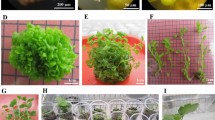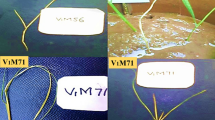Abstract
Mutation breeding is one of the most effective techniques in plant breeding. Mutagens are used to induce variation in plants. Ethyl methanesulfonate is considered the most effective mutagen among chemical mutagens. The doses and treatment durations of the used mutagens become important to create an effective mutation. Four different doses of ethyl methanesulfonate (0.0, 0.2, 0.4 and 0.6%) were used to treat the tuber eyes for two different time periods (3 and 6 h) in the present study. After treatment, molecular characterization was examined in plants developed from ethyl methanesulfonate-treated tuber eyes by inter-simple sequence repeat method in order to determine the genetic differences which ethyl methanesulfonate treatments led to create in plants. The research showed that there was a 7–48% similarity rate of the plants from the eyes treated with ethyl methanesulfonate. The genetic similarity rate was 7% between 0.4% dose of ethyl methanesulfonate for 3 h and its 0.2% dose for 6 h, but it was 82% for the control groups (untreated-ethyl methanesulfonate). The lowest similarity rate (10%) between control groups (untreated-ethyl methanesulfonate) and EMS treatments occurred at 0.4% dose of ethyl methanesulfonate for 3 h.



Similar content being viewed by others
References
Albani MC, Wilkinson MJ (1998) Inter simple sequence repeat polymerase chain reaction for the detection of somaclonal variation. Plant Breed 117:573–575
Altındal N (2014) Induction of variation using chemical mutagene (ethyl methanesulfonate) treatment and characterization by molecular markers in potato (Solanum tuberosum L.). Ph.D. thesis, Süleyman Demirel University, Graduate School of Natural and Applied Sciences, Field Crops Department, p 140
Altındal D, Altındal N (2018) Effect of ethyl methanesulphonate (EMS) applications on in vitro growth of sunflower (Helianthus annuus L. cv. Palancı-I) under salinity conditions. J Inst Sci Technol 8(4):351–359
Altındal D, Altındal N, Akgün İ (2017) Molecular characterization of triticale genotypes (X Triticosecale Wittmack) based on ISSR-PCR. J Tekirdag Agric Faculty 14(03):19–26
Anonymous (2018) Helianthus tuberosus. http://antropocene.it/2018/11/27/helianthus-tuberosus. Accessed 05 May 2019
Antony R, Joseph J, Bastian D, Menon MV (2018) In vitro mutagenesis creates distinct morphological variants in cassava (Manihot esculenta Crantz.): a characterisation study. Electron J Plant Breed 9(2):433–449
Avery NC, Jain GS (1996) Influence of uranyl nitrate on seed germination and early seedling growth of Vigna radiata L. Wilczek. Binotes 15(2):79–83
Badawi MA, Taha SS, Al-Hamada RI, Abdelaziz ME (2015) Effect of ethyl methanesulfonate (EMS) mutagen on genetic variability, growth characters and yield of potato. Middle East J Agric Res 4(4):1076–1087
Baldini M, Danuso F, Rocca A, Bulfoni E, Monti A, Mastro GD (2011) Jerusalem artichoke (Helianthus tuberosus L.) productivity in different Italian growing areas: a modelling approach. Italian J Agron 6(e20):126–132
Bidabadi SS, Meon S, Wahab Z, Subramaniam S, Mahmood M (2012) Induced mutations for enhancing variability of banana (Musa spp.) shoot tip cultures using ethyl methanesulphonate (EMS). Aust J Crop Sci 6(3):391–401
Bock DG, Kane NC, Ebert DP, Rieseberg LH (2014) Genome skimming reveals the origin of the Jerusalem Artichoke tuber crop species: neither from Jerusalem nor an artichoke. New Phytol 201:1021–1030
Çolak AM, Alan F (2017) Molecular characterization of different currant types. Int J Agric For Life Sci 1(1):21–26
Cvejić S, Afza R, Jocić S, Prodanović S, Miklić V, Škorić D, Dragin S (2011) Radiosensitivity of sunflower inbred lines to mutagenesis. Helia 34(54):99–106
Doyle JJ, Doyle JL (1987) A rapid DNA isolation procedure for small quantities of fresh leaf tissue. Phytochem Bull 19:11–15
Ehsanpour AA, Madani S, Hoseini M (2007) Detection of somaclonal variation in potato callus induced by UV-C radiation using RAPD-PCR. Gen Appl Plant Physiol 33:3–11
Elias R, Till BJ, Mba C, Al-Safadi B (2009) Optimizing TILLING and Ecotilling techniques for potato (Solanum tuberosum L). BMC Res Notes 2:141
Gong S, Fu H, Wang J (2010) ISSR analysis of M1 generation of Gladiolus hybridus Hort. treated by EMS. J Northeast Agric Univ 17(2):22–26
Greene EA, Codomo CA, Taylor NE, Henikoff JG, Till BJ (2003) Spectrum of chemically induced mutations from a large-scale reverse-genetic screen in Arabidopsis. Genetics 164:731–740
Gunn RE, Shepard JF (1981) Regeneration of plants from mesophyll-derived protoplasts of British potato (Solanum tuberosum L.) cultivars. Plant Sci Lett 22:97–101
Ismail MA, Heakal MY, Fayed A (1977) Improvement of yield through induced mutagenesis in broad beans. Ind J Genet Plant Breed 36(3):347–350
Jabeen N, Mirza B (2002) Ethyl methane sulphonate enhances genetic variability in Capsicum annuum. Asian J Plant Sci 1(4):425–428
Jain SS, Ahloowalia BS, Veilleux RE (1998) Somaclonal variation in crop improvement. In: Jain MS, Brar DS, Ahloowalia BS (eds) Somaclonal variation and induced mutations in crop improvement. Kluwer Acdemic Publishers, London, pp 203–217
Kavithamani D, Kalamani A, Vanniarajan C, Uma D (2010) Development of new vegetable soybean (Glycine max L. Merill) mutants with high protein and less fibre content. Electron J Plant Breed 1(4):1060–1065
Khan S, Wani MR, Parveen K (2006) Sodium azide induced high yielding early mutant in lentil. Agric Sci Digest 26(1):65–66
Khidr YA, Arafa MM, Eldemery SMM, Elsanhoty RM (2017) Molecular and morphological evaluation of potato genotypes cultivated in sandy soil. Egypt J Genet Cytol 46:1–17
Kumar G, Kumar Rai P (2007) EMS induced karyomorphological variations in maize (Zea mays L.) inbreds. TUBİTAK Turk J Biol 31:187–195
Kurobane TH, Yanaguchi HY, Sander C, Nilan RA (1979) The effects of gamma irradiation on the production and secretion of enzymes and enzymatic activities in barley. Environ Exp Bot 19:75–84
Lestari EG (2012) Combination of somaclonal variation and mutagenesis for crop improvement. J AgroBiogen 8(1):38–44
Luan Y-S, Zhang J, Gao X-R, An L-J (2007) Mutation induced by ethylmethanesulphonate (EMS), in vitro screening for salt tolerance and plant regeneration of sweet potato (Ipomoea batatas L.). Plant Cell Tissue Organ Cult 88:77–81
Mensah JK, Akomeah PA (1992) Mutagenic effects of hydroxylamine and streptomycin on the growth and seed yield of cowpea (Vigna unguiculata L. Walp). Legume Res 15(1):39–44
Minocha JL, Arnason TJ (1962) Mutagenic effectiveness of ethyl methane sulphonate in barley. Nature 196:499
Mohamed MF, Abd El-Fattah BES, Nassef DMT, Aboul Nasr MH, Kandee NNM (2018) Phenotypic and molecular alterations of potato (Solanum tuberosum L.) cv. ‘Cara’ as affected by benzyl adenine and propagation cycle in vitro. Egypt J Hortic 45(2):205–228
Moon K-B, Ahn D-J, Park J-S, Jung WY, Cho HS, Kim H-R, Jeon J-H, Park Y-i, Kim H-S (2018) Transcriptome profiling and characterization of drought-tolerant potato plant (Solanum tuberosum L.). Mol Cells 41(11):979–992
Mornkham T, Wangsomnuk PP, Wangsomnuk P, Jogloy S, Pattanothai A, Fu YB (2012) Comparison of five DNA extraction methods for molecular analysis of Jerusalem artichoke (Helianthus tuberosus). Genet Mol Res 11(1):572–581
Onamu R, Legaria J, Rodríguez JL, Sahagùn J, Pèrez J (2016) Molecular characterization of potato (Solanum tuberosum L.) genotypes using random amplified polymorphic DNA (RAPD) and inter simple sequence repeat (ISSR) markers. Afr J Biotechnol 15(22):1015–1025
Parry MA, Madgwick PJ, Bayon C, Tearall K, Hernandez-Lopez A, Baudo M, Rakszegi M, Hamada W, Al-Yassi A, Ouabbou H (2009) Mutation discovery for crop improvement. J Exp Bot 60:2817–2825
Powell W, Morgante M, Andre C, Hanafey M, Vogel J, Tingey S, Rafalski A (1996) The comparison of RFLP, RAPD, AFLP and SSR (microsatellite) markers for germplasm analysis. Mol Breed 2(3):225–238
Rohlf FJ (1991) NTSYS-pc, numerical taxonomy and multivariate analysis system. Exeter Software, Setauket
Roychowdhury R, Datta S, Gupta P, Tah J (2012) Analysis of genetic parameters on mutant populations of mungbean (Vigna radiata L.) after ethyl methane sulphonate treatment. Not Sci Biol 4(1):137–143
Sabetta W, Alba V, Blanco A, Montemurro C (2011) sunTILL: a tilling resource for gene function analysis in sunflower. Plant Methods 7:20
Semagn K, Rnstad B, Ndjiondjop MN (2006) An overview of molecular marker methods for plants. Afr J Biotechnol 5:2540–2568
Singh S, Richharia AK, Joshi AK (1998) An assessment of gamma ray induced mutations in rice (Oryza sativa L.). Ind J Genet Plant Breed 58(4):455–463
Somalraju A, Ghose K, Main D, Bizimungu B, Fofana B (2019) Development of pre-breeding diploid potato germplasm displaying wide phenotypic variations as induced by ethyl methane sulfonate mutagenesis. Can J Plant Sci 99:138–151
Taheri S, Abdullah TL, Ahmad Z, Abdullah NAP (2014) Effect of acute gamma irradiation on Curcuma alismatifolia varieties and detection of DNA polymorphism through SSR marker. BioMed Res Int 2014:245–256
Ulukapi K, Nasircilar AG (2018) Induced mutation: creating genetic diversity in plants. Provisional chapter. IntechOpen, London, pp 1–15
Van Harten AM (1998) Mutation breeding theory and practical applications. Cambridge University Press, Cambridge, pp 127–140
Vogel EW, Natarajan AT (1995) DNA damage and repair in somatic and germ cells in vivo. Mutat Res 330:183–208
Wakui K, Hiroyoshi W, Takahashi Y, Takahashi Y, Fujigaki J (2009) Assessment of the congruity of genetic relationships and variation revealed by individual-and bulked-samples-based approaches using RAPD and ISSR markers in Japanese turnip (Brassica rapa ssp. rapa) cultivars. Breed Sci 59:447–452
Yang S, Sun X, Jiang X, Wang L, Tian J, Li L, Zhao M, Zhong Q (2019) Characterization of the Tibet plateau Jerusalem artichoke (Helianthus tuberosus L.) transcriptome by de novo assembly to discover genes associated with fructan synthesis and SSR analysis. Hereditas 156(9):1–13
Zietkiewicz E, Rafalski JA, Labuda D (1994) Genome fingerprinting by simple sequence repeat (SSR)-anchored polymerase chain reaction amplification. Genomics 20:176–183
Acknowledgements
I am thankful to Dr. Demet ALTINDAL for his assistance in carrying out the experiments. The reviewers who critically checked my article and research deserve special thanks.
Author information
Authors and Affiliations
Corresponding author
Additional information
Editorial responsibility: M. Abbaspour.
Rights and permissions
About this article
Cite this article
Altindal, N. Molecular characterization of Helianthus tuberosus L. treated with ethyl methanesulfonate based on inter-simple sequence repeat markers. Int. J. Environ. Sci. Technol. 16, 5311–5318 (2019). https://doi.org/10.1007/s13762-019-02486-1
Received:
Revised:
Accepted:
Published:
Issue Date:
DOI: https://doi.org/10.1007/s13762-019-02486-1




